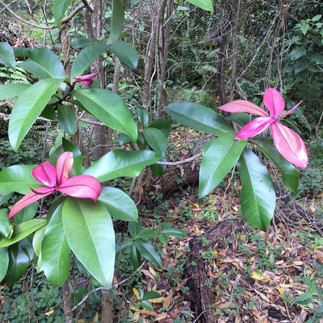It’s—both; it’s kolea! Like Superman, the word kolea does double duty. It refers to both the migratory bird and the forest-dwelling tree. Kolea, the bird, is a golden plover (Pluvialis fulva) which flies here each winter to escape the cold and fatten up. It’s always on its own and is often seen on well-maintained lawns. Kolea are very alert birds, with big black eyes always on the lookout for insects and potential predators. They have brown, black and white feathers which take on a striking appearance before they leave for the Arctic in the spring.
In the case of the plant, kolea refers to two different tree species, kolea lau nui (Myrsine lessertiana) and kolea lau li’i (Myrsine sandwicensis). Lau nui means large leaf and lau li’i means small leaf. The more common of these two endemic trees is kolea lau nui. It has smooth, leathery green leaves with a prominent mid-rib. Sometimes the new leaves will come out bright pink, a beautiful sight.
Why do a bird and a plant have the same name? Is it just a fluke or was it the outcome of some lost connection? Ancient Hawaiians sometimes gave the same name to completely different species. An example of this is loulu. We know loulu as a name for the native fan palm, but it is also the name for the Scrawled Filefish, which has a long tail fin that can be displayed as a fan. But the link does not have to be visual; it could be cultural or mythological. In the case of kolea, it is something once known but now perhaps lost to Father Time.






Comments